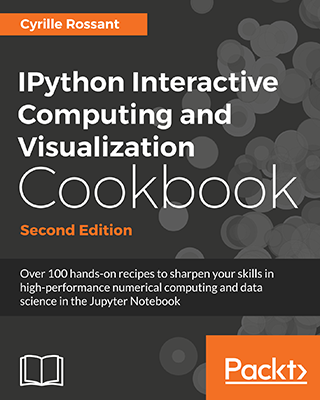4.3. Profiling your code line-by-line with line_profiler
 This is one of the 100+ free recipes of the IPython Cookbook, Second Edition, by Cyrille Rossant, a guide to numerical computing and data science in the Jupyter Notebook. The ebook and printed book are available for purchase at Packt Publishing.
This is one of the 100+ free recipes of the IPython Cookbook, Second Edition, by Cyrille Rossant, a guide to numerical computing and data science in the Jupyter Notebook. The ebook and printed book are available for purchase at Packt Publishing.
▶ Text on GitHub with a CC-BY-NC-ND license
▶ Code on GitHub with a MIT license
▶ Go to Chapter 4 : Profiling and Optimization
▶ Get the Jupyter notebook
Python's native cProfile module and the corresponding %prun magic break down the execution time of code function by function. Sometimes, we may need an even more fine-grained analysis of code performance with a line-by-line report. Such reports can be easier to read than the reports of cProfile.
To profile code line-by-line, we need an external Python module named line_profiler. In this recipe, we will demonstrate how to use this module within IPython.
Getting ready
To install line_profiler, type conda install line_profiler in a terminal.
How do to it...
We will profile the same simulation code as in the previous recipe, line-by-line.
1. First, let's import NumPy and the line_profiler IPython extension module that comes with the package:
import numpy as np %load_ext line_profiler 2. This IPython extension module provides an %lprun magic command to profile a Python function line-by-line. It works best when the function is defined in a file and not in the interactive namespace or in the Notebook. Therefore, here we write our code in a Python script using the %%writefile cell magic:
%%writefile simulation.py import numpy as np def step(*shape): # Create a random n-vector with +1 or -1 values. return 2 * (np.random.random_sample(shape)<.5) - 1 def simulate(iterations, n=10000): s = step(iterations, n) x = np.cumsum(s, axis=0) bins = np.arange(-30, 30, 1) y = np.vstack([np.histogram(x[i,:], bins)[0] for i in range(iterations)]) return y 3. Now, let's import this script into the interactive namespace so that we can execute and profile our code:
from simulation import simulate 4. We execute the function under the control of the line profiler. The functions to be profiled need to be explicitly specified in the %lprun magic command. We also save the report in a file named lprof0:
%lprun -T lprof0 -f simulate simulate(50) *** Profile printout saved to text file 'lprof0'. 5. Let's display the report:
print(open('lprof0', 'r').read()) 
How it works...
The %lprun command accepts a Python statement as its main argument. The functions to profile need to be explicitly specified with -f. Other optional arguments include -D, -T, and -r, and they work in a similar way to their %prun magic command counterparts.
The line_profiler module displays the time spent on each line of the profiled functions, either in timer units or as a fraction of the total execution time. These details are essential when we are looking for hotspots in our code.
There's more...
Tracing is a related method. Python's trace module allows us to trace program execution of Python code. That's particularly useful during in-depth debugging and profiling sessions. We can follow the entire sequence of instructions executed by the Python interpreter. More information on the trace module is available at https://docs.python.org/3/library/trace.html.
In addition, the Online Python Tutor is an online interactive educational tool that can help us understand what the Python interpreter is doing step-by-step as it executes a program's source code. The Online Python Tutor is available at http://pythontutor.com/.
Here are a few references:
line_profilerrepository at https://github.com/rkern/line_profiler
See also
- Profiling your code easily with cProfile and IPython
- Profiling the memory usage of your code with memory_profiler